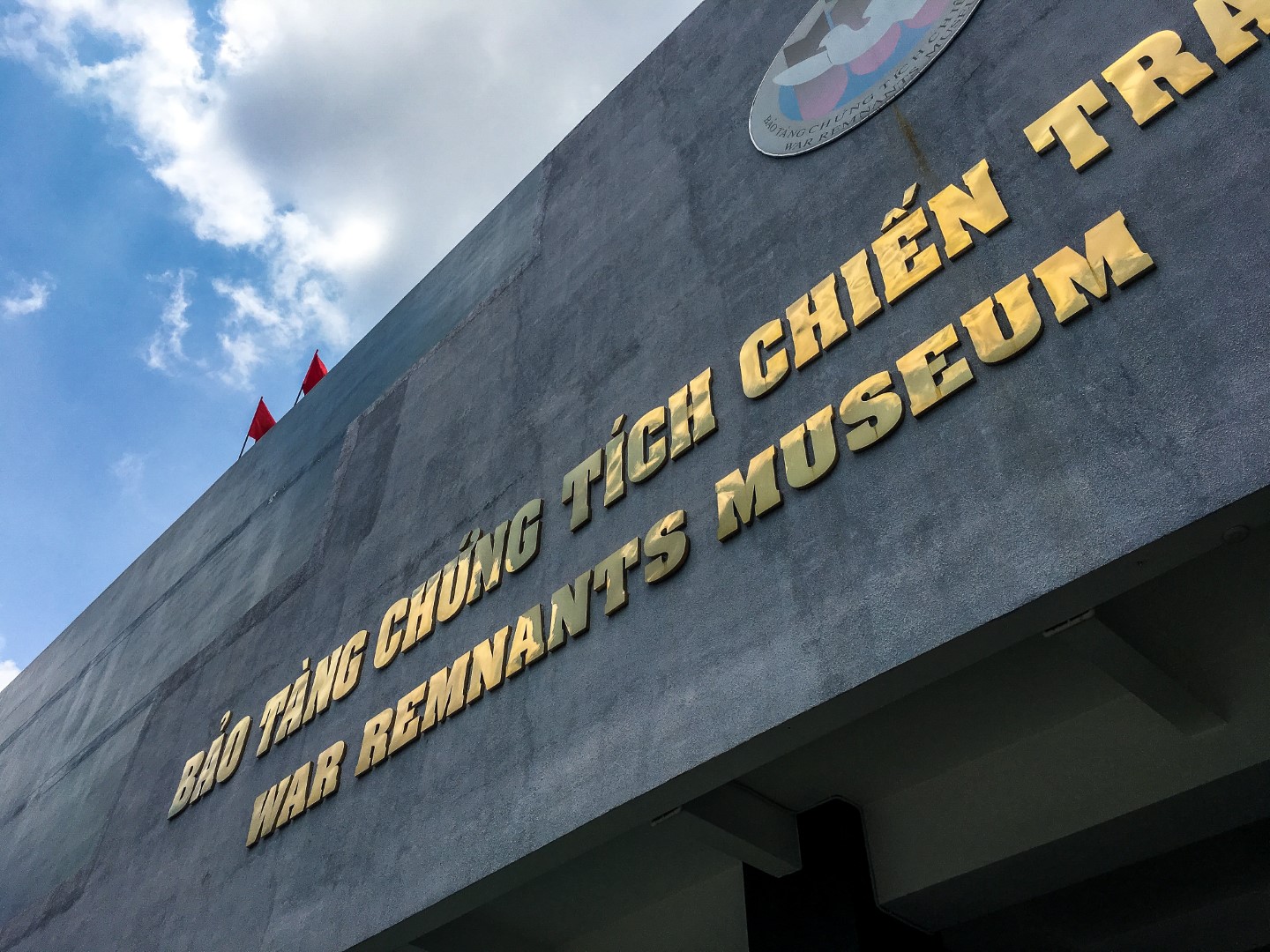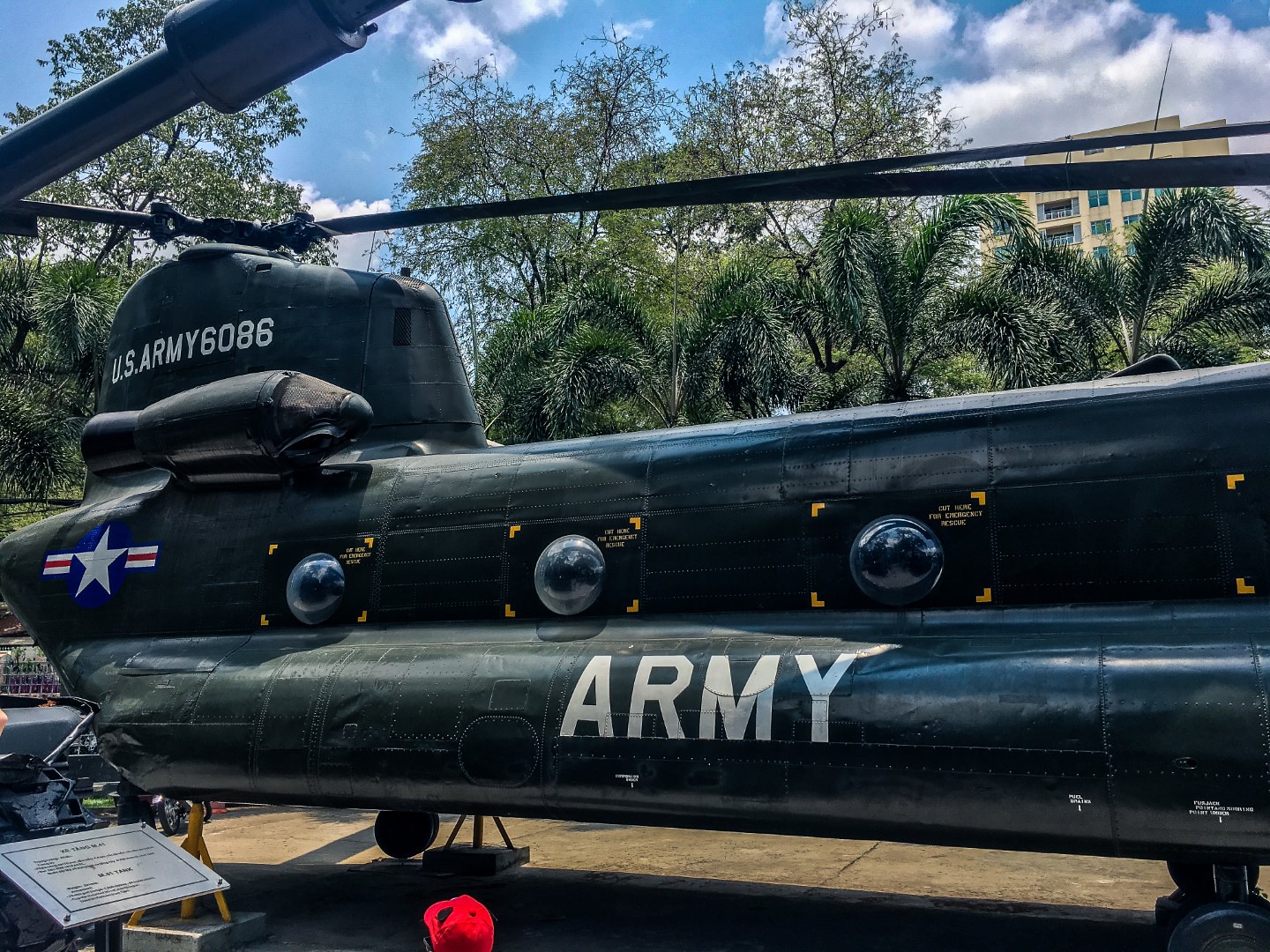
Awaken to the sounds of construction in the vacant block next door. Excavator is pushing dirt around, filling in a muddy hole. I spot about 10 health and safety concerns in the space of about two minutes. The sun is rising, and soon it will be too hot for them to work. We see them later snoozing in plastic chairs near an iced coffee seller.
Today we’ve decided to take on the Independence Palace and the War Remnants Museum before the city is cooked under the sun. Stuff faces with omlettes and a mound of pastries for breakfast. One of the better things left behind by the French. The breakfast buffet is quiet – we’re up early today and the usual collection of touring families haven’t surfaced yet.
Set off for the Palace, threading our way through buildings and motorcycles alike. Secretly high five self for managing to cross the road without a close call. I realise later that I’ve congratulated myself too early, as I’m set upon by a hustler. This bloke’s got more front than David Jones. He starts by walking in front of us, shouting friendly remarks over his shoulder – “I sell everything, now I go home. Tomorrow holiday!”. I stupidly join in on his happy talk, and he hands me a coconut. ‘Gift!’ he declares. Okay. In a flash he hands Husbando a coconut and asks for the equivalent of six dollars. Nah, no thank you. A confused but short negotiation follows. I end up parting with 50k Dong for one coconut which he opens, and then he’s off across the road to another group. It’s all done in less than 60 seconds, and I’m still not sure what’s gone on. I spot more of them later. Lesson learned – coconuts are not actually gifts.
There’s no line to get into the Palace – probably because we’re here in the hot season. From the outside, it looks like a huge block of concrete. It’s not adorned with any great beauty outside save for the sprawling gardens and the fountain. Reunification Day is approaching, and school children are visiting in droves. They chatter excitedly, snapping photos of their friends pulling faces in front of the fountain. Two tanks are parked in the grounds, which they gather around as the teacher spouts a narrative. I wonder if these are the tanks from the famous footage of the North Vietnamese Army crashing through the gates and signalling the end of the war?

Inside the building is a complete contrast to the outside. Follow the map through the maze of hallways and peer into each room. The rooms are all grand in scale and decor. Plush, rich coloured carpets, teak dining tables to seat 30 people, intricately carved wooden thrones. Deep regal reds, sleek gold. There’s a movie theatre and a ladies lounge, furnished in 70’s style complete with loud orange lamp shades. The guest apartments which have housed celebrities and dignitaries alike are beautifully appointed, opening onto a private courtyard complete with bonsai-clad water feature. The president’s bedroom is large, spacious, still with personal effects laid out for viewing. There’s a door labelled ‘escape passage’ which leads to the bunker, also open for viewing.
It’s a test for my claustrophobia – heavy concrete, low ceilings and hot stuffy air. Communications room, radio room and the defence minister’s office – which became the control centre for the South Vietnamese forces during the war. On the roof, two circles are painted, marking the spot where two bombs fell through the ceiling – dropped by a North Vietnamese pilot. Behind this, a military helicopter. Relics of a war the West seems to have forgotten are laid bare for all to see. A constant reminder, like a scar on skin. It was a little odd to stand there, where the tanks crashed through the gates and Saigon fell – in the place that held the power of South Vietnam one day and none of it the next.
Return to the street and make our way to the War Remnants Museum. Avoid coconut sellers and shoe shiners. The closer we get to the museum, the more I notice small blue stickers with a white dove on everything. They bloom, like wildflowers, on light poles and metal boxes. I bake, like a pancake, under the sun. The stickers, we discover, are the entry tickets to the museum. You must wear it on your shirt while you peruse the exhibits.

In the grounds of the War Remnants Museum, its strangely quiet. The traffic falls away, and there is no laughing children, no shouting. Only the sound of explosions, piped into the grounds by speakers in the garden. There is an immense sense of dread and guilt, as though we know what we’re all about to see. Except we don’t know.
I take photos of the US Army chinook helicopter and a few of the other aircraft and tanks in the ground, but I feel odd. I don’t know how to feel, or if I should be taking these photos. There’s even a collection of bomb casings, in various sizes in one corner. Most are taller than me, one is twice as wide. Examples of explosives which rained down on this country and its people.
Inside the museum, there are several floors of exhibits. People move silently between them, some look decidedly sick. All exhibits are from the perspective of the Vietnamese, and there is some propaganda. It is, however, intensely graphic. They describe in great detail the weapons used, the effect on the human body, the terrible human toll. The effects of napalm, phosphorus bombs and Agent Orange are truly horrific, and the museum displays this without the censorship we in the West have grown so accustomed to. Photographs paper the walls of each exhibit, some cruelly colourised to ensure there is no mistake: that is a dismembered human body part. The bombs stopped falling decades ago, but locals are still reeling from the effects of the weapons. Trauma, birth defects, unexploded ordinance – it’s a story without a happy ending. Without an ending at all to be honest. Husbando can hardly stand to look by the end. The museum is a blatant and cold look at the darkest side of humanity. It’s a lot to digest, and we leave wondering what hope humanity has for itself.
Flashes of the museum still churn through my head days later. It’s gut wrenching, to see what humans are capable of inflicting on each other. My skin crawls at the thought. But its an unavoidable part of Vietnam. It is inextricably woven into the fabric of the country and the history of the people. Everyone carries some form of trauma. It is essential that people, especially travellers, understand what happened and not just the glorified Western tales. The war was brutal, with near immeasurable human cost.
Head back out to the road. Walk in silence for a while, eventually hailing a cab and heading for the hotel. Sweet lady of air conditioning.
Christ on a wheel, I need a stiff drink.
Notes:
- You can tour the Independence Palace on your own, or with an audio guide. Just head to the desk just inside the entrance.
- The War Remnants Museum is not the place for selfies or gallivanting.
- The coconut sellers and shoe shiners are most prevalent around both the palace and the museum. They’re most harmless, so don’t worry too much.
Enjoying reading my diary so far? You can find more of my Vietnam entries here, or catch up on my Cambodian adventures.